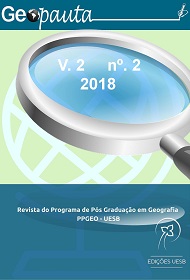Challenges and prospects for family farming in the municipality of Ribeirópolis - SE
DOI:
https://doi.org/10.22481/rg.v2i2.2735Keywords:
Family farming. Pluriativity. Rural Development.Abstract
The aim of this work is to understand the spatial dynamic that involves the family farm in the municipality of Ribeirópolis/SE, with the field of analysis, seeking to identify the factors that can be understood as acting on the reproduction of family units This municipality. Thus, from the review of selected literature and through discussions at weekly meetings held in the research group on Rural and Regional Dynamics (GDRR), in addition to secondary data collection and analysis, one can substantiate theoretical and empirically research in question, in addition to conducting fieldwork where questionnaires were applied and conducted semi-structured interviews. You can highlight even if rents from non-agricultural activities, scanned from the fieldwork, are activities of type Mason, General Services Assistant, painter, cleaner and marchante. . In these terms, the study may provide new perspectives on the new rural reality, as well as, public intervention strategies, to provide subsidies that contribute to the inclusion of small producers in the production system. Therefore, it was concluded that even not showing the same potential for other areas of Brazil, the diversification of the work represents, for the family units, pluriativas a relevant alternative for the farmers of the municipality of Ribeirópolis/SE.
Downloads
Metrics
References
CORRÊA, Roberto Lobato. Espaço um Conceito Chave. In: Geografia Conceitos e Temas. Bertrand Brasil. Rio de Janeiro, 2000.p. 15-48.
FAJARDO, Sergio. Complexo agroindustrial, modernização da agricultura e participação das cooperativas agropecuárias no estado do Paraná. - revista on line caminhos da geografia. Uberlândia, v. 9, n. 27, set. 2008, p. 31-44.
GRAZIANO DA SILVA, José. A nova dinâmica da agricultura brasileira. Campinas: Unicamp-IE, 1996.
______. O novo rural brasileiro. Nova Economia, v. 7, n. 1. Belo Horizonte- MG, 1997. p. 43-81.
______. Os desafios das Agriculturas Brasileiras. In: José Garcia Gasques, José Eustáquio Ribeiro Vieira Filho, Zander Navarro, (organizadores). A Agricultura Brasileira: desempenho, desafios e perspectivas / - Brasília: Ipea, 2010. p. 157-184.
______. A industrialização e urbanização da agricultura brasileira. Versão de um trabalho apresentado ao projeto Iris/Desep-Cut fevereiro de 1993, p.1-9.
GRAZIANO DA SILVA, José. & DEL GROSSI, M. E. A evolução da agricultura familiar e do agribusiness nos anos 90. In: RATTNER, H. (Org.) O Brasil no limiar do século XXI. São Paulo: EDUSP, p. 139-158, 2000.
LEITE, Sérgio Peite; KATO, Karina. Desafios dos processos de Gestão Social e proposições de Política. In: BARCELAR, Tânia,..[et.al] Gestão social dos territórios – Brasília: IICA, (Série Desenvolvimento Rural Sustentável: v.10), 227 p. 2009.
LOPES, Eliano Sérgio A. A pluriatividade na agricultura familiar do Estado de Sergipe. In: COSTA, J. E.; LOPES, S. A. (organizadores).Territórios Rurais e Agricultura Familiar no Nordeste. São Cristóvão: Editora UFS, 2009.
MARTINS, José de S. O sujeito oculto: ordem e transgressão na reforma agrária. Porto Alegre, RS: UFRGS, 2003.
MENDES, Marcelo Alves. Os (des) caminhos geográficos e a pluriatividade na agricultura familiar: aspectos teóricos e cotidianidade da agricultura familiar no Nordeste. São Paulo: Novas Edições Acadêmicas, 2014. v. 200. 261p.
NASCIMENTO, Carlos A. do. Pluriatividade, pobreza rural e políticas públicas. . (Tese de Doutorado). Campinas-SP: INSTITUTO DE ECONOMIA, UNICAMP/IE, 2005.
SCHNEIDER, Sergio. Agricultura familiar e desenvolvimento rural endógeno. Texto apresentado no Seminário de Desenvolvimento Rural - Tendências e debates contemporâneos. Realizado em 26 e 27 de maio de 2003, pela UFSM, em Santa Maria/RS/ Publicado em 2006.
______. As atividades rurais não agrícolas e as transformações do espaço rural: perspectivas recentes. Cuadernos de Desarrollo Rural. v. 1 n. 44, Bogotá, 2000, p. 11-40.
______. A importância da pluriatividade para as políticas públicas no Brasil. Revista Política Agrícola, Brasilia, Ano XVI, nº 3, Jul./Set./ 2007.
______. Políticas públicas pluriatividade e desenvolvimento rural no Brasil. ANAIS, Políticas publicas y desarrolho rural, en el VII Congresso De La Asociación Latino Americana de Sociología Rural/ALASRU-20-24 de Novimbre del 2006- Quito, Equador, p. 1-20.
______. Situando o desenvolvimento rural no Brasil: o contexto e as questões em debate. Revista de Economia Política, São Paulo, v.30, n. 3, p. 511 531, julho setembro/2010.
SEN, Amartya. Desenvolvimento como liberdade. Tradução Laura Teixeira Motta - São Paulo: Companhia de letras, 2010. 461 p. 4ª reimpressão.
WANDERLEY, Maria de N. B.O lugar dos rurais: o meio rural no Brasil moderno. Resumo dos Anais do XXXV Congresso Brasileiro de Economia e Sociologia Rural. Natal – RN, 1997.
Downloads
Published
How to Cite
Issue
Section
License
Copyright (c) 2018 from the Geopauta Journal and the Author(s)

This work is licensed under a Creative Commons Attribution 4.0 International License.
Copyright
Authors must retain unrestricted copyright and grant the Geopauta the first publication with the work simultaneously licensed under CC BY which allows others to share with recognition of each author's authorship in the initial publication in this Journal
Intellectual Property and Terms of Use
Geopauta adopts the Free Access policy in accordance with Open Access - OAC recommended by DOAJ and in accordance with the SciELO Criteria, under a Creative Commons CC By Attribution 4.0 International License, allowing immediate free access to the work and allowing any user to read, download, copy, distribute, print, search or link to the full texts of the articles, track them for indexing, pass them as data to software or use them for any other legal purpose.
Geopauta attributes the CC BY. license. where it is allowed without restrictions:
Share — copy and redistribute the material in any medium or format for any purpose, even commercial. as long as they give due credit for the original creation.
Adapt — remix, transform, and create from the material for any purpose, even commercial purposes, as long as due credit is given for the original creation.












